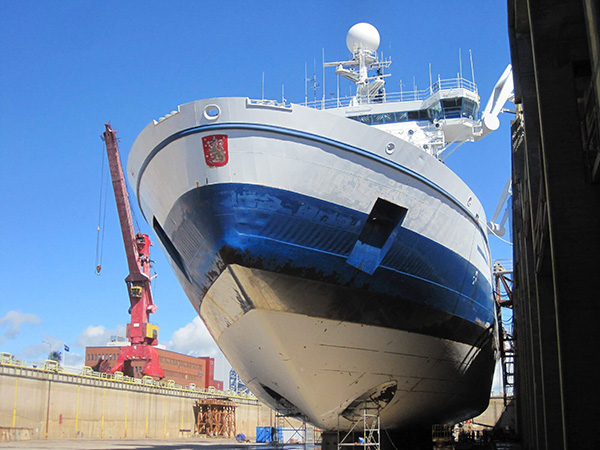Environment
Equipment
Machinery
Five icebreakers in the pipeline?
Sweden and Finland are joining forces to create the next generation of green icebreakers

Finland and Sweden have been considering a joint purchase of icebreakers for a couple of years now. In March 2020, the Swedish Maritime Administration and the Finnish Transport Infrastructure Agency began collaborating on the design of a modern ice breaker concept.
Finland is thinking about getting 1–2
icebreakers and Sweden could order
as many as three. It is no surprise that
Sweden
has its eye on more icebreakers
than Finland, since the Swedish icebreaker
fleet is also smaller. But the fact remains
that both Sweden and Finland have outdated
icebreaker fleets, and the next generation
of icebreakers is required.
Presently, a lot of freight is being
moved from road transport to ships, and,
of course, a major part of Finnish and
Swedish foreign trade is shipped by sea.
The ports in the Gulf of Bothnia need to
remain open and accessible all year round
– so those icebreakers need to be ready
to perform.

Update the old formula
Finland and Sweden want to create a different
type of icebreaker that is able to serve ever wider ships, as well as cope with
new ice characteristics. It appears that a
milder climate with more wind and less
widespread ice can, actually, make navigation
more difficult in ice-covered waters.
For example, in the coming years we’re
likely to see pack ice and ice ridges that
are tougher than solid ice.
tougher than solid ice.
In addition, the demand for icebreaker
assistance has changed in recent
years. While ships are getting bigger, environmental
standards limit their power
somewhat – and thus their ability to navigate
ice-covered waters unaided is compromised.
The Nordic icebreaker project is estimated
to come with a price tag in excess
of billion euros. Both the Swedish Maritime
Administration and the Finnish Transport
Infrastructure Agency recommend state
funding for the undertaking.

14 icebreakers right now
Presently, there are five active icebreakers
in Sweden and nine in Finland, a fleet
that was partly developed in collaboration
between the countries in the 1970s. That’s
when the five Urho/Atle class icebreakers
were built, together with the sister ships
Sisu, Ymer and Frej.
Therefore, this is not the first time
that the two countries are working
together on icebreaking innovation. In
addition, Finland brings into the project
its rather recent experience from Polaris,
the LNG-powered ice breaker built five
years ago.
Mika Laurilehto, CSO, Rauma Marine
Constructions (RMC), says that the Swedish
Maritime Administration has already
made preliminary inquiries about whether
RMC would be interested in building the
vessels. Laurilehto deems the project
worthwhile and, in fact, really necessary:
“It is clear that the sea lanes in the
Baltic Sea area must stay open throughout
the coldest months of the year. The icebreaker
fleet in the Baltic has to be able to
perform their invaluable tasks also in the
future,” he says.

Wanted more sustainable icebreakers
Laurilehto says that the next generation of
icebreakers must respond to great expectations
when it comes to performance and
eco-friendliness.
“Their emissions must be significantly
lower than those of their predecessors
in the Urho and Atle class. Also, they
must be able to break a 32-metre-wide
channel in the ice, endure tough conditions
that are becoming even more severe,
and operate for up to 50 years,” he runs
down the list of requirements.
shipyard must have know-how in arctic
shipbuilding and the ability to implement
new technology and innovations in
a way that increases the icebreaking capabilities
of the vessels while cutting down
emissions. Moreover, previous experience
from public-sector procurements plays
an important role: knowing the process
and necessary preparations makes collaboration
between the buyer and builder
smoother.
RMC knows icebreakers
”Shipbuilders in Rauma have plenty of
experience in building vessels for challenging
weather conditions”, Laurilehto
points out.
“RMC has been operating the Rauma
shipyard from 2014, and during this time
we have upgraded the operative capabilities
of icebreaker Otso, done a general overhaul
and modernisation of research vessel
Aranda, and built two car and passenger
ferries: Hammershus, completed in 2018,
and Aurora Botnia, completed in 2021.”
What is noteworthy, as well, is that
RMC’s vessels are not produced in series.
They are novel and technically advanced,
state-of-the-art products tailored to the
buyer’s needs. “When it comes to technology
development projects and future
innovations, RMC works in close cooperation
with universities, equipment suppliers
and other partners.”

Icebreakers in 2070?
”Naturally, the long lifespan of new icebreakers
poses a significant challenge
to shipbuilding. Requirements related
to power generation and emissions will
change in fifty years, and they will be difficult
to anticipate”, says Laurilehto.
“However, decisions must be made
now so that the current emission reduction
goals can be achieved. The technology for
decarbonising marine transport already
exists. What we need now is collaboration
between companies and the public sector,
and across industries and geographic
borders.” In the industry, bio-based fuels
and battery technology are the main
solutions considered to have the most
potential for the near future.
Laurilehto sees public procurements
as “spearheads for industrial development
and success” in Finland and Sweden. Likewise,
the procurement of new icebreakers
offers an opportunity to develop new technologies
and the maritime industry cluster.
“A joint project between Finland and
Sweden would restore the role of the two
countries’ maritime clusters as global leaders
in arctic expertise. Moreover, it would
safeguard national security of supply in
terms of export and import by sea. All necessary
competence and technology can be
found in the Nordics,” he believes.
“Nonetheless, before the vessels can
be built, the Finnish and Swedish governments
must work together and make creative
decisions to ensure that the project
can be carried out in a cost-effective way –
while promoting environmentally sustainable
seafaring.”
by: Sami J. Anteroinen
photos: Rauma Marine Constructions



